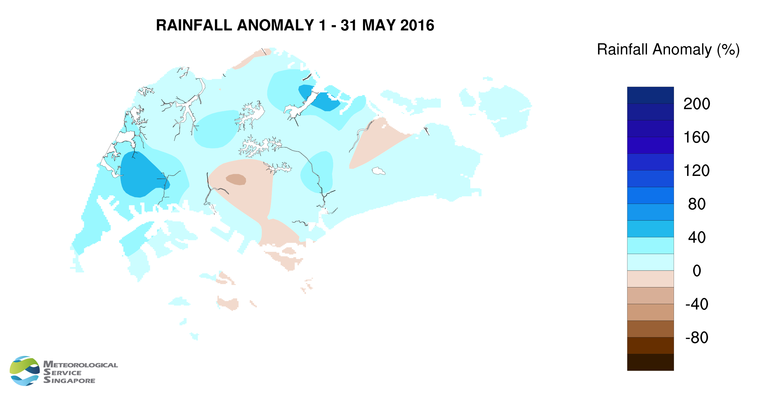Near normal weather conditions expected with end of the El Nino
Advisory
Singapore, 1 June 2016 – In the first half of June 2016, the prevailing low level winds are forecast to blow predominantly from the southeast or southwest. This signals the start of the Southwest Monsoon season which typically extends from June to September/early October.
2 In the first fortnight of June 2016, short-duration thundery showers can be expected mostly in the late morning and early afternoon on five to seven days due to strong solar heating of land areas and convergence of winds in the surrounding vicinity. In addition, thundery showers with gusty winds due to Sumatra squalls are likely on one to two days in the pre-dawn and morning. Rainfall for the first fortnight of June 2016 is expected to be slightly below average.
3 During the outlook period, daily maximum temperatures of between 32°C and 33°C are expected on most days, and could reach around 34°C on a few days. During the Southwest Monsoon season, the nights can be relatively warm, in particular on non-rain days. This usually occurs when the winds are light and blow from the southeast, bringing in warm, humid air from the sea toward the land.
4 With the weakening of the El Nino to neutral conditions in the equatorial Pacific Ocean, close to normal rainfall and temperatures can be expected for Singapore in the next one or two months. However international climate centres forecast that a La Nina could develop in the later part of the year, and this usually brings above average rainfall to our surrounding region.
REVIEW (1 – 31 May 2016)
5 Inter-Monsoon conditions prevailed over the region in May 2016. Towards the end of the month, the prevailing light and variable winds gradually strengthened and blew from the southeast or southwest, indicating a transition to Southwest Monsoon conditions.
6 In the first fortnight of May 2016, the days were significantly warmer than usual and the highest daily maximum temperature ranged between 32.8°C and 36.1°C. An increase in the occurrence of rain showers in the second half of May 2016 brought cooler days with the daily maximum temperature ranging between 31.2°C and 35.4°C. Despite the cooler conditions in the second half of the month, the mean monthly temperature of 29.3°C for May 2016 recorded at the Changi climate station was still 1.0°C warmer than the long term mean temperature for May. May 2016 was the second warmest May since Singapore temperature records began in 1929, tying with the record set in May 1997.
7 On most days in May 2016, the thundery showers in the afternoon were due to strong solar heating of land areas coupled with the convergence of winds over Singapore. In the later part of the month, the presence of the monsoon rain band close to Singapore coupled with the presence of tropical cyclones in the Bay of Bengal and southern China, led to the passage of Sumatra squalls which brought widespread thundery showers and gusty winds to Singapore between midnight and early morning on some days. The showers were heaviest on 11 May 2016 where the highest daily rainfall total recorded was 99.8mm around Yishun.
8 Most parts of Singapore received above average rainfall in May 2016. The highest rainfall of 341mm (61% above average) was recorded around Seletar. Rainfall was lowest around Clementi where 165mm (30% below average) was recorded. The mean rainfall recorded at the climate station in May 2016 was 194.2mm, about 23mm above the long-term mean rainfall for May of 171.2mm.
CLIMATE STATION STATISTICS FOR JUNE (Climatological reference period: 1981 – 2010)
| Mean daily maximum temperature | 32.0 °C |
| Mean daily minimum temperature | 25.4 °C |
| Mean monthly temperature | 28.3 °C |
| Mean rainfall for the month | 130.7 mm |
| Mean number of rain days | 12 |
| Highest monthly mean daily maximum temperature | 33.2 °C (1997) |
| Lowest monthlymean daily minimum temperature | 24.4 °C (1989) |
| Highest monthly rainfall | 265.8 mm (1996) |
| Lowest monthly rainfall | 21.8 mm (2009) |

